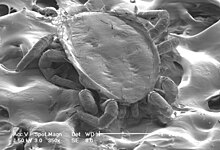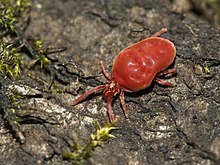Prostigmata
| Prostigmata | ||||||||||||
|---|---|---|---|---|---|---|---|---|---|---|---|---|

Lorrya formosa from the family Tydeidae |
||||||||||||
| Systematics | ||||||||||||
|
||||||||||||
| Scientific name | ||||||||||||
| Prostigmata | ||||||||||||
| Kramer , 1877 |

The Prostigmata , formerly Actinedida called, are a taxon within the mites (Acari). With around 20,000 species, they comprise almost half of all mite species and are distributed both terrestrially and in freshwater and in the ocean. You can find them in every habitat because of their small size and adapted way of life. They feed predatory or on plant remains and fungi or live as commensals or parasites .
In the classical systematic classification of arachnids , the mites represented an order and the trombidiformes (Actinedida) a subordinate order. In other systems they are an independent order within the superordinate Acariformes in the subclass of the mites (Acari). The prostigmata are regarded by some authors as a paraphyletic collective taxon in which all mites have been classified that are not typical astigmata or oribatida .
features
Prostigmata differ from astigmata mainly in the absence of some features. In contrast to the Oribatida, their body shell is only weakly or only partially sclerotized. The remaining astigmata, however, are soft-skinned. The gnathosoma of the prostigmata rarely shows paired rutella and the chelicerae are rarely scissor-shaped. Pseudostigmata are also absent on the propodosoma . In contrast to the astigmata, the palps are three to five limbed and large and the tarsi rarely have organs similar to suction cups.
The different lifestyles of around 150 prostigmatic families has led to numerous adaptations. The group is morphologically very heterogeneous. The smallest representative is 0.65 mm long, the largest 1.8 mm. The back armor of the front body ( prosoma ) is divided into two sections, the front and larger propeltidium and the smaller metapeltidium. Some species breathe through the skin, in others a respiratory system within the body is responsible for the oxygen supply. If there is one, it ends with two breath openings ( stigmata ) at the base of the chelicerae . The location of the stigmata is also an important taxonomic characteristic and distinguishes the prostigmata from other groups of mites.
distribution and habitat
The types of prostigmata are widespread worldwide, their occurrence ranges from the Antarctic to northern latitudes, across all climatic zones. They not only colonize terrestrial habitats, but are also at home in fresh water and the sea.
Systematics
Familys:
- Acalyptonotidae
- Acarophenacidae
- Acucapitidae
- Adamystidae
- Alicorhagiidae
- Allochaetophoridae
- Amoenacaridae
- Amphotrombiidae
- Anisitsiellidae
- Anystidae
- Apheviderulicidae
- Arenohydracaridae
- Arrenuridae
- Astacocrotonidae
- Athienemanniidae
- Athyreacaridae
- Aturidae
- Audyanidae
- Barbutiidae
- Bdellidae
- Bembidiacaridae
- Bimichaeliidae
- Bogatiidae
- Caeculidae
- Caligonellidae
- Calyptostomatidae
- Camerobiidae
- Caraboacaridae
- Chappuisididae
- Cheyletidae
- Chyzeriidae
- Cloacaridae
- Crotalomorphidae
- Cryptognathidae
- Ctenothyadidae
- Cunaxidae
- Dasythyreidae
- Hair follicle mites (Demodicidae), with the genus of the hair follicle mites ( Demodex )
- Diptilomiopidae
- Dolichocybidae
- Ereynetidae
- Eriophyidae ( gall mites )
- Eriorhynchidae
- Erythreidae
- Eupalopsellidae
- Eupatrellidae
- Eupodidae
- Eylaidae , with the eyeglass mite ( Eylais extendens )
- Feltriidae
- Ferradasiidae
- Grandjeanicidae
- Gretacaridae
- Halacaridae
- Harpagopalpidae
- Harpyrhynchidae
- Heterocheylidae
- Homocaligidae
- Hungarohydracaridae
- Hydrachnidae , with the spheroid mite ( Hydrachna globosa )
- Hydrodromidae , with the yellow-footed mite (Hydrodroma despiciens)
- Hydrovolziidae
- Hydryphantidae , with the spot mite ( Panisus michaeli ) and the saddle mite ( Hydryphantes ruber )
- Hygrobatidae , with the hedgehog mite ( Hygrobates longipalpis ) and the sickle- foot mite ( Atractides ovalis )
- Iolinidae
- Johnstonianidae
- Kantacaridae
- Krendowskiidae
- Labidostommatidae
- Laversiidae
- Lebertiidae , with the bouncy mite ( Lebertia insignis ) and the rune mite ( Lebertia glabra )
- Leeuwenhoekiidae
- Limnesiidae , with the genus of pond mites ( Limnesia )
- Limnocharidae , with the sac mite ( Limnochares aquatica )
- Limnohalacaridae
- Linotetranidae
- Lordalychidae
- Mecognathidae
- Microdispidae
- Micropsammidae
- Mideidae
- Mideopsidae
- Momoniidae
- Myobiidae
- Nalepellidae
- Nanorchestidae
- Nematalycidae
- Neoacaridae
- Neothrombiidae
- Neotrombidiidae
- Nipponacaridae
- Oehserchestidae
- Omartacaridae
- Ophioptidae
- Oxidae , with the crustacean mite ( Frontipoda musculus )
- Paratydeidae
- Pentapalpidae
- Pentasetacidae
- Penthaleidae
- Penthalodidae
- Pezidae
- Phytoptidae
- Piersigiidae
- Pionidae
- Platyglyphidae
- Podapolipidae
- Pomerantziidae
- Pontarachnidae
- Proteonematalycidae
- Proterorhagiidae
- Pseudocheylidae
- Psorergatidae
- Pterygosomatidae
- Pyemotidae
- Pygmephoridae
- Raphignathidae
- Rhagidiidae
- Rhynchohydracaridae
- Rutripalpidae
- Scutacaridae
- Siteroptidae
- Smarididae
- Sperchontidae , with the source mite ( Sperchon glandulosus )
- Sphaerolichidae
- Stigmaeidae
- Strandtmanniidae
- Stygothrombiidae
- Stygotoniidae
- Syringophilidae
- Tarsocheylidae
- Tarsonemidae
- Teneriffiidae
- Tenuipalpidae
- Teratothyadidae
- Terpnacaridae
- Spider mites (Tetranychidae), with the common spider mite ( Tetranychus urticae ) and the red spider ( Panonychus ulmi )
- Teutoniidae
- Thermacaridae
- Torrenticolidae
- Trombellidae
- Trombiculidae
- Running mites (Trombidiidae), with the red velvet mite ( Trombidium holosericeum )
- Trombidiidae
- Tuckerellidae
- Tydeidae
- Uchidastygacaridae
- Unionicolidae , with the glass mite ( Neumania vernalis )
- Vatacaridae
- Walchiidae
- Wettinidae
- Xenocaligonellididae
- Yurebillidae
literature
- Gerald W. Krantz: A manual of acarology. 2nd Edition. Oregon State University Book Stores, Corvallis OR 1978, ISBN 0-88246-064-1 .
proof
- ^ A b Matthias Schaefer: Brohmer - Fauna of Germany. A book of identification of our native fauna. 19th, revised edition. Quelle & Meyer, Heidelberg et al. 1994, ISBN 3-494-01225-3 , pp. 145-146.
- ↑ a b Actinedida at zipcodezoo.com ( Memento from December 2, 2008 in the Internet Archive )
